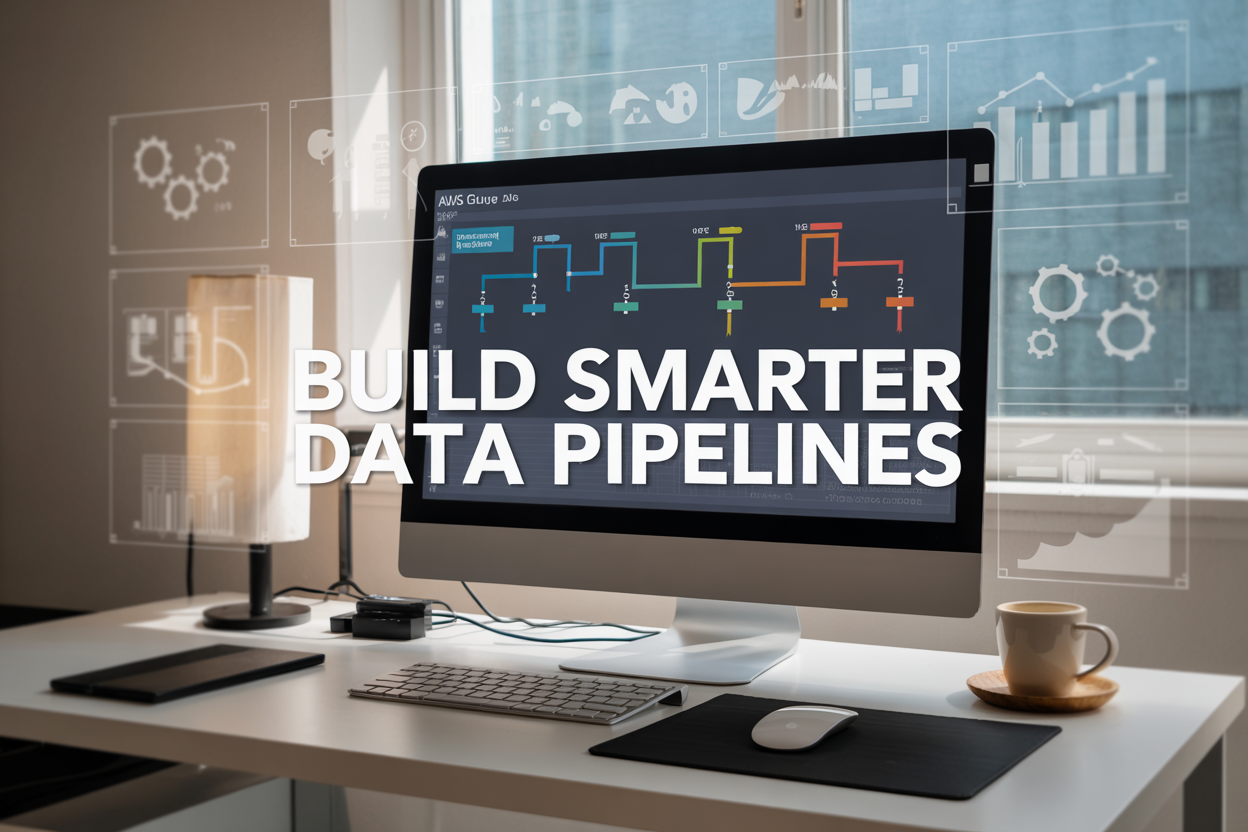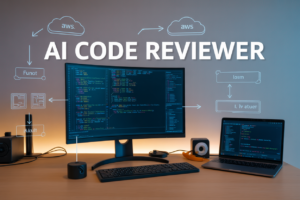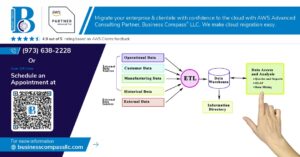Deploying reinforcement learning models to production can feel like navigating a maze, especially when you’re working with complex reasoning frameworks like SimpleRL-Reason. This guide walks you through the complete process of AWS SageMaker deployment for production ready reinforcement learning systems, giving you the roadmap to turn your experimental models into scalable, reliable services.
This tutorial is designed for ML engineers, data scientists, and DevOps professionals who have built SimpleRL-Reason models and need to deploy them at scale. You’ll learn practical steps to move beyond proof-of-concept demos into systems that can handle real user traffic and business requirements.
We’ll cover three critical areas that make or break RL model deployment AWS success. First, you’ll master building Docker containers machine learning teams can trust, including proper dependency management and configuration for SimpleRL-Reason pipeline components. Second, we’ll dive into SageMaker endpoints configuration for both real-time inference and batch processing SageMaker workflows, showing you how to handle different traffic patterns and computational needs. Finally, you’ll discover ML model monitoring AWS strategies that keep your reinforcement learning production systems running smoothly, including automated alerting and performance tracking that actually matter in production environments.
Understanding SimpleRL-Reason Architecture for Production Environments
Core components and workflow of SimpleRL-Reason pipelines
SimpleRL-Reason pipelines combine reinforcement learning agents with reasoning modules to make intelligent decisions in complex environments. The architecture includes three primary components: the RL agent that learns optimal policies through trial and error, the reasoning engine that processes symbolic knowledge and logical constraints, and the integration layer that orchestrates communication between these systems. Data flows from environment observations through the RL agent’s neural networks, while the reasoning module validates decisions against predefined rules and constraints. This hybrid approach enables more robust decision-making by combining the adaptability of RL with the interpretability of symbolic reasoning systems.
Performance requirements and scalability considerations
Production SimpleRL-Reason deployments demand careful attention to latency and throughput requirements, especially when serving real-time inference requests through SageMaker endpoints. The reasoning component often becomes the bottleneck due to symbolic computation overhead, requiring optimized algorithms and efficient memory management. Horizontal scaling strategies work best for batch processing scenarios, while vertical scaling suits real-time inference needs. Memory requirements scale with the complexity of reasoning rules and the size of RL model parameters. GPU acceleration benefits the neural network components, but CPU resources remain critical for symbolic processing tasks.
Integration points with cloud infrastructure
AWS SageMaker provides multiple integration touchpoints for SimpleRL-Reason pipelines through its managed infrastructure services. Model endpoints handle real-time inference requests with automatic scaling capabilities, while processing jobs manage large-scale batch operations. The pipeline integrates with S3 for model artifacts and training data storage, CloudWatch for monitoring and logging, and IAM for security and access control. Container-based deployments through SageMaker support custom Docker images that package both RL frameworks and reasoning libraries. API Gateway can route external requests to SageMaker endpoints, enabling seamless integration with existing applications and microservices architectures.
Data flow and processing requirements
Data preprocessing for SimpleRL-Reason systems involves transforming raw observations into formats suitable for both neural networks and symbolic reasoning engines. Input pipelines must handle structured data for reasoning rules alongside numerical features for RL agents. The system requires bidirectional data flow between components, with RL outputs feeding into reasoning validation and reasoning constraints influencing RL action selection. Batch processing workflows need efficient data partitioning strategies to handle large-scale training and inference tasks. Storage requirements include versioned model checkpoints, reasoning rule databases, and training experience buffers, all of which must be accessible across distributed computing nodes in the cloud environment.
Preparing Your Development Environment for AWS SageMaker Deployment
Setting up AWS credentials and permissions
Start by creating an IAM role with SageMaker full access, S3 read/write permissions, and CloudWatch logging capabilities. Configure your AWS CLI with aws configure or use IAM roles for EC2 instances. Set up separate roles for training jobs and endpoint deployment to follow the principle of least privilege. Store credentials securely using AWS Secrets Manager for production environments.
Configuring Docker containers for SimpleRL-Reason
Your SimpleRL-Reason pipeline needs a custom Docker image that includes all reinforcement learning dependencies and frameworks. Create a Dockerfile based on the SageMaker Python SDK base image, install your RL libraries, and copy your training scripts. Build multi-stage Docker containers to reduce image size – use one stage for building dependencies and another for the runtime environment. Tag images appropriately for version control.
Managing dependencies and environment variables
Pin exact versions of critical packages like TensorFlow, PyTorch, and SimpleRL-Reason in your requirements.txt file. Use environment variables for configuration parameters like learning rates, episode counts, and model paths. Set up separate environment files for development, staging, and production deployments. Implement proper logging configuration through environment variables to capture training metrics and debugging information effectively.
Building Production-Ready SimpleRL-Reason Docker Images
Optimizing image size and performance
Multi-stage Docker builds dramatically reduce your SimpleRL-Reason container size by separating build dependencies from runtime requirements. Start with a Python 3.9 slim base image, install only production dependencies, and remove unnecessary packages like development tools and documentation. Use .dockerignore to exclude training data, notebooks, and test files. Alpine Linux variants can cut image size by 60-70% compared to Ubuntu bases. Layer caching works best when you copy requirements files first, install dependencies, then add your application code. This approach ensures dependency layers remain cached during code changes, speeding up builds significantly.
Implementing proper logging and monitoring hooks
Structured JSON logging with AWS CloudWatch integration ensures your RL models remain observable in production. Configure Python’s logging module to output JSON format with correlation IDs, request metadata, and performance metrics. Hook into SageMaker’s built-in logging by writing to /opt/ml/output/logs/ for automatic CloudWatch forwarding. Add custom metrics for reward signals, episode completion rates, and model inference latency. Use environment variables to control log levels between development and production. Implement health check endpoints that return model status, memory usage, and processing queue depth for SageMaker load balancers.
Handling model artifacts and configuration files
Store trained RL models in S3 with versioned paths following the pattern /models/{model_name}/{version}/. Your Docker container should download model artifacts during startup using boto3, not bundle them in the image. This keeps images lightweight and enables A/B testing between model versions. Configuration management works best with environment variables for simple settings and JSON files for complex hyperparameters. Mount configuration files from S3 or use AWS Systems Manager Parameter Store for sensitive values. Implement graceful model reloading without container restart by watching S3 events or scheduled refresh intervals.
Security hardening and vulnerability scanning
Run containers as non-root users and create dedicated service accounts with minimal IAM permissions. Your SimpleRL-Reason containers need only S3 read access for models and CloudWatch write permissions for logging. Use AWS ECR image scanning to detect vulnerabilities in base images and dependencies. Pin package versions in requirements.txt to prevent supply chain attacks during builds. Enable Docker content trust and sign your production images. Remove shell access and debugging tools from production containers. Implement secrets rotation for API keys and database credentials using AWS Secrets Manager integration.
Configuring SageMaker Endpoints for Real-Time Inference
Selecting optimal instance types and auto-scaling policies
Choose instance types based on your SimpleRL-Reason model’s computational requirements. For lightweight policy inference, start with ml.t3.medium instances, but complex reasoning models need ml.c5.xlarge or ml.g4dn.xlarge for GPU acceleration. Configure auto-scaling with target tracking policies that scale on invocations per instance rather than CPU utilization – RL models often have unpredictable compute patterns. Set minimum capacity to 2 instances for high availability and maximum capacity to prevent runaway costs. Test scaling behavior thoroughly since SimpleRL-Reason pipelines can have cold start delays during model initialization.
Setting up model loading and initialization processes
Structure your inference container to preload SimpleRL-Reason components during container startup rather than first request. Create initialization scripts that load the trained policy network, reasoning modules, and environment configurations into memory. Implement lazy loading for large model artifacts and cache frequently accessed components. Use SageMaker’s model loading hooks to validate model integrity and compatibility before accepting traffic. Design your initialization process to fail fast if critical components are missing or corrupted, preventing silent failures in production.
Implementing health checks and error handling
Design robust health checks that verify your SimpleRL-Reason pipeline’s complete functionality, not just container responsiveness. Create endpoints that test policy inference, reasoning capabilities, and data preprocessing pipelines with synthetic inputs. Implement graceful degradation when components fail – return simplified responses rather than complete failures. Log detailed error information for debugging while returning clean error messages to clients. Set appropriate timeout values for SageMaker endpoints based on your model’s inference latency, typically 30-60 seconds for complex RL reasoning tasks.
Configuring network security and VPC settings
Deploy SageMaker endpoints within your VPC to control network access and data flow. Configure security groups that allow inbound traffic only from authorized sources and outbound traffic to necessary AWS services. Use VPC endpoints for S3 and other AWS services to keep traffic within your private network. Implement encryption in transit using TLS and at rest for model artifacts. Create IAM roles with least privilege access – separate roles for endpoint execution, model loading, and monitoring. Consider using AWS PrivateLink for additional security when accessing endpoints from other AWS services.
Managing endpoint versioning and A/B testing
Implement blue-green deployments for SimpleRL-Reason model updates using SageMaker’s built-in traffic shifting capabilities. Start with 10% traffic to new model versions and gradually increase based on performance metrics. Use variant weights to split traffic between different model architectures or hyperparameter configurations. Tag endpoints and variants with meaningful version identifiers and deployment metadata. Create rollback procedures that can quickly revert to previous model versions if performance degrades. Monitor key RL metrics like reward distribution and action diversity across different endpoint variants to detect model degradation early.
Implementing Batch Processing Workflows with SageMaker Processing Jobs
Designing efficient data ingestion pipelines
Building scalable data ingestion for SimpleRL-Reason requires careful orchestration of input streams and preprocessing stages. Set up S3-based data lakes with partitioned structures that align with your RL training cycles. Implement Lambda triggers for automatic processing job initiation when new training data arrives. Use SageMaker Data Wrangler to define reusable transformation workflows that handle feature engineering, reward signal preprocessing, and experience replay buffer management. Configure CloudWatch Events to monitor data quality metrics and trigger alerts when anomalies occur in your reinforcement learning datasets.
Optimizing resource allocation for large-scale processing
Smart resource allocation makes the difference between cost-effective and expensive batch processing SageMaker workflows. Choose instance types based on your SimpleRL-Reason model’s computational profile – GPU instances for neural network components and CPU instances for symbolic reasoning tasks. Implement auto-scaling policies that adjust cluster sizes based on queue depth and processing time requirements. Use Spot instances for non-time-critical training jobs to reduce costs by up to 70%. Set memory and CPU limits per container to prevent resource contention when running multiple RL agents simultaneously across distributed processing jobs.
Managing job scheduling and dependency handling
Production RL model deployment AWS requires sophisticated orchestration to handle complex training pipelines and model updates. Build dependency graphs using AWS Step Functions to coordinate data preprocessing, model training, evaluation, and deployment stages. Implement retry logic with exponential backoff for transient failures and circuit breakers for persistent issues. Use SageMaker Pipelines to create repeatable workflows that automatically trigger when performance metrics fall below thresholds. Set up job prioritization queues to ensure critical model updates take precedence over routine retraining tasks while maintaining system stability.
Monitoring and Maintaining Production SimpleRL-Reason Systems
Setting up comprehensive logging and metrics collection
Production SimpleRL-Reason pipeline deployments require robust observability through CloudWatch integration and custom metrics. Configure structured logging for your SageMaker endpoints using JSON formatters to capture model predictions, latency metrics, and error rates. Set up CloudWatch dashboards to track inference throughput, memory usage, and RL model deployment AWS performance indicators. Implement distributed tracing with AWS X-Ray to monitor request flows across your reinforcement learning production system components.
Implementing automated alerting for system anomalies
Create CloudWatch alarms for critical metrics like endpoint response times exceeding thresholds, error rate spikes, and resource utilization anomalies. Configure SNS topics to trigger automated responses when ML model monitoring AWS detects performance degradation. Set up Lambda functions for immediate incident response, including automatic scaling adjustments or failover procedures. Use CloudWatch Composite Alarms to correlate multiple metrics and reduce false positives in your alerting system.
Performance optimization and cost management strategies
Monitor your SageMaker real-time inference costs using AWS Cost Explorer and implement auto-scaling policies based on traffic patterns. Optimize Docker container resource allocation by analyzing memory and CPU utilization metrics over time. Consider using SageMaker Multi-Model Endpoints for cost-effective hosting of multiple SimpleRL-Reason models. Implement request batching and caching strategies to reduce inference costs while maintaining acceptable response times for your production workloads.
Managing model updates and rollback procedures
Establish blue-green deployment patterns using SageMaker endpoint configurations to safely deploy updated SimpleRL-Reason models. Implement automated rollback triggers based on key performance indicators like accuracy drops or increased error rates. Use SageMaker Model Registry to version control your models and maintain deployment history. Create automated testing pipelines that validate model performance against production traffic before promoting new versions, ensuring seamless updates without service disruption.
Deploying SimpleRL-Reason pipelines on AWS SageMaker transforms your reinforcement learning models from experimental prototypes into robust, scalable production systems. We’ve walked through the complete journey – from understanding the architecture and setting up your development environment to building Docker images, configuring endpoints, and implementing batch workflows. The key to success lies in careful preparation of your containerized environments and thoughtful configuration of SageMaker’s powerful infrastructure.
Don’t forget that launching your models is just the beginning. Setting up proper monitoring and maintenance routines will keep your SimpleRL-Reason systems running smoothly in production. Start with a small-scale deployment to test your setup, then gradually scale up as you gain confidence in your pipeline’s performance. Your reinforcement learning models are ready to make real-world impact – now it’s time to deploy them with confidence.



















